
Batman is a 1989 superhero film based on the DC Comics character of the same name, created by Bob Kane and Bill Finger. Directed by Tim Burton, it is the first installment of Warner Bros.' initial Batman film series. The film was produced by Jon Peters and Peter Guber and stars Jack Nicholson, Michael Keaton, Kim Basinger, Robert Wuhl, Pat Hingle, Billy Dee Williams, Michael Gough, and Jack Palance. The film takes place early in the title character's war on crime and depicts his conflict with his archenemy The Joker.
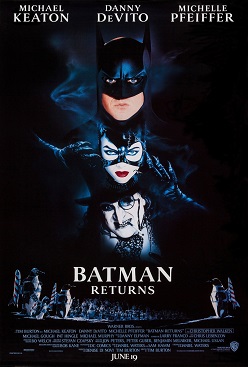
Batman Returns is a 1992 American superhero film directed by Tim Burton and written by Daniel Waters. Based on the DC Comics character Batman, it is the sequel to Batman (1989) and the second installment in the 1989–1997 Batman series. In the film, the superhero vigilante Batman comes into conflict with wealthy industrialist Max Shreck and deformed crime boss Oswald Cobblepot / The Penguin, who seek power, influence, and respect regardless of the cost to Gotham City. Their plans are complicated by Selina Kyle, Shreck's formerly-meek secretary, who seeks vengeance against Shreck as Catwoman. The cast includes Michael Keaton, Danny DeVito, Michelle Pfeiffer, Christopher Walken, Michael Gough, Pat Hingle, and Michael Murphy.

Timothy Walter Burton is an American filmmaker, animator, and artist. Known for pioneering goth culture in the American film industry, Burton is revered for his gothic horror and fantasy films. These include Beetlejuice (1988), Edward Scissorhands (1990), The Nightmare Before Christmas (1993), Ed Wood (1994), Sleepy Hollow (1999), Corpse Bride (2005), Sweeney Todd: The Demon Barber of Fleet Street (2007), and Dark Shadows (2012), as well as the television series Wednesday (2022). Burton also directed the superhero films Batman (1989) and Batman Returns (1992), the sci-fi film Planet of the Apes (2001), the fantasy-drama Big Fish (2003), the musical adventure film Charlie and the Chocolate Factory (2005), and the fantasy films Alice in Wonderland (2010) and Miss Peregrine's Home for Peculiar Children (2016).

Daniel Michael DeVito Jr. is an American actor, comedian, and filmmaker. He gained prominence for his portrayal of the taxi dispatcher Louie De Palma in the television series Taxi (1978–1983), which won him a Golden Globe Award and an Emmy Award. He plays Frank Reynolds on the FX and FXX sitcom It's Always Sunny in Philadelphia (2006–present).
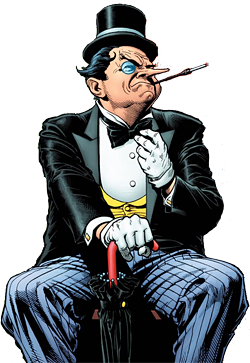
The Penguin is a supervillain appearing in American comic books published by DC Comics, commonly as an adversary of the superhero Batman. The character made his first appearance in Detective Comics #58 and was created by Bob Kane and Bill Finger. The Penguin is one of Batman's most enduring enemies and belongs to the collective of adversaries that make up Batman's rogues gallery.

Catwoman is a fictional character created by Bill Finger and Bob Kane who appears in American comic books published by DC Comics, commonly in association with the superhero Batman. Debuting as "the Cat" in Batman #1, she is one of the Dark Knight's most notable enemies and belongs to the collective of adversaries that make up his rogues' gallery. However, the character has also been depicted as an antiheroine and become Batman's best known and most enduring love interest, with many stories depicting their complex love–hate relationship. Since 1993, Catwoman has had her own ongoing series, Catwoman.
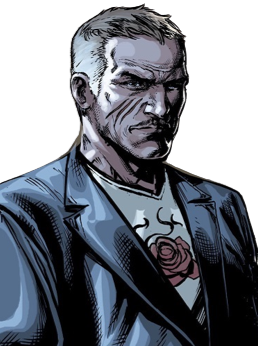
Carmine Falcone is a fictional supervillain in DC Comics, portrayed as a powerful mob boss, an enemy of Batman, and a friend of the Wayne family. He has also been depicted in some versions as the illegitimate father of Catwoman.

Batman: The Long Halloween is a 13-issue American comic book limited series written by Jeph Loeb with art by Tim Sale. It was originally published by DC Comics in 1996 and 1997. It was the follow-up to three Batman: Legends of the Dark Knight Halloween Specials by the same creative team. The series' success led to Loeb and Sale to reteam for two sequels, Batman: Dark Victory and Catwoman: When in Rome, which are set concurrently.

The Batman vs. Dracula is a 2005 American direct-to-video animated superhero-horror film based on The Batman television series. The film is a crossover with the 1897 horror novel Dracula. The film was released to DVD on October 18, 2005, and made its television debut on Cartoon Network's Toonami block on October 22. In the film, the Batman races to save Gotham City from his most challenging foe yet: the legendary vampire Count Dracula, who hatches a plot together to enslave the city and create a race of vampires along with his two new henchmen, the Penguin and the Joker. It was released on DVD as a tie-in with the live action Batman Begins.

Batman: Nine Lives is an Elseworlds graphic novel published by DC Comics in 2002, written by Dean Motter, with art by Michael Lark.

The Joker, a supervillain in DC Comics and archenemy of the superhero Batman, has appeared in various media. WorldCat records over 250 productions featuring the Joker as a subject, including films, television series, books, and video games. Live-action films featuring the character are typically the most successful.
Catwoman is a fictional character first appearing in issue 1 of the Batman comic book. After her debut she would appear in many forms of media including live-action and animated film, radio, live-action and animated television, records, video games, web series, live performance, and podcasts. The character has made live-action appearances in the Batman television series (1966–68), its film adaptation Batman (1966), Batman Returns (1992), Catwoman (2004),The Dark Knight Rises (2012), Gotham (2014–19), and The Batman (2022). The character has also appeared in numerous animated television series and movies, most notably Batman: The Animated Series (1992–95) and The Lego Batman Movie (2017), as well as video games such as the Batman: Arkham series.
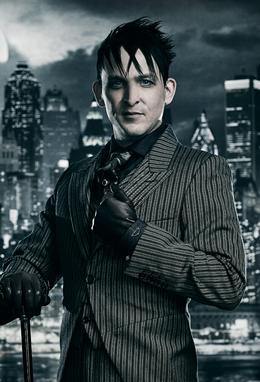
Oswald Cobblepot is a character and one of the main antagonists of the FOX television series Gotham, portrayed by Robin Lord Taylor. Based on the DC Comics supervillain of the same name, he was adapted by showrunner Bruno Heller for the series, which is intended to explore the origin stories of characters from the Batman mythos. Introduced in the first season, Cobblepot is depicted as an intelligent low-level thug who aspires to become a leading crime lord in Gotham City. The series explores his rise to power and the challenges he faces in achieving this goal.

"The Beginning..." is the series finale of the American television series Gotham, based on the DC Comics characters Jim Gordon and Bruce Wayne. It is the twelfth episode of the fifth season and the 100th overall episode of the series. The episode was written by showrunner John Stephens and directed by Rob Bailey.

Selina Kyle, commonly known as Catwoman, is a fictional character who appears in Tim Burton's Batman film series and is based on the DC Comics character of the same name. She is portrayed by American actress Michelle Pfeiffer. This is often considered to be one of Pfeiffer's finest performances, even though she regarded it as one of her most uncomfortable, due to the sheer discomfort and inhibitions she suffered through while wearing the costume. The character debuted in the 1992 film Batman Returns.
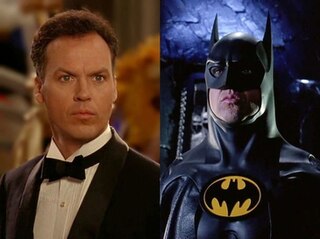
Bruce Wayne, better known by his vigilante superhero alias Batman, is a fictional character who is featured as the main protagonist in Warner Bros.' initial Batman film series (1989–1997), and later as a supporting character in the DC Extended Universe (DCEU) film The Flash (2023). Based on the DC Comics character of the same name, he was portrayed by Michael Keaton in Tim Burton's Batman (1989) and Batman Returns (1992), before being recast with Val Kilmer and George Clooney in Joel Schumacher's Batman Forever (1995) and Batman & Robin (1997) respectively.

The fictional supervillain Penguin, created by Bob Kane and Bill Finger, made his first appearance in Detective Comics #58. Since then, he has been adapted into other forms of media, including feature films, television series, and video games.
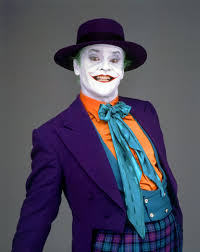
Jack Napier, also known as the Joker, is a fictional character introduced in the 1989 superhero film Batman, directed by Tim Burton. Primarily portrayed by Jack Nicholson, the character was based on the DC Comics supervillain the Joker. His name is a play on the word Jackanapes, as well as a reference to the names Jack Nicholson and Alan Napier, the latter having portrayed Alfred Pennyworth in the 1960s Batman TV series and having died the previous year. This depiction is notable for being one of the first adaptations of the character to have a distinct first and last name, as well as one of the few instances which show his origins. This iteration of the Joker is a psychopathic gangster who serves as the right-hand man of Gotham City crime boss Carl Grissom until he is disfigured following a confrontation with the vigilante Batman; his disfigurement drives him insane, and he becomes a costumed criminal obsessed with "out-doing" the Dark Knight, who he believes is getting too much press.

















